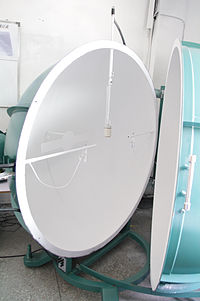
Photo from wikipedia
Gamma-ray measurements in terrestrial/environmental samples require the use of high efficient detectors because of the low level of the radionuclide activity concentrations in the samples; thus scintillators are suitable for… Click to show full abstract
Gamma-ray measurements in terrestrial/environmental samples require the use of high efficient detectors because of the low level of the radionuclide activity concentrations in the samples; thus scintillators are suitable for this purpose. The design of 4πNaI(Tl) parallelepiped γ-ray scintillation detector with central square left void is considered an instructive case in radiation measurements, where it can be easily used in several critical applications including medical therapy, radiation protection, environmental exposure monitoring and neutron interaction. It is also extremely important to measure the activities of low radioactivity samples. Therefore, the understanding of the full scope of the multidimensional calibration and measurement process must be done with high accuracy. The present work is essentially concerned in introducing a new numerical evaluation to calculate the geometrical and total efficiency of a 4πNaI(Tl) parallelepiped scintillator detector using isotropic radiating γ-ray point source. Also the average path lengths traveled by the photon inside the detector active medium have been calculated in order to study the characteristics of the source-to-detector configurations. This method depends mainly on the calculation of the solid angle subtended to the radioactive point source situated at various positions inside the detector and the photon path lengths through the detector active medium. In addition, the attenuation of the stainless steel absorber between the source and the detector material has been studied. The obtained results were compared with Monte Carlo and experimental published data to show the method's validity in the calibration process.
Journal Title: Radioprotection
Year Published: 2017
Link to full text (if available)
Share on Social Media: Sign Up to like & get
recommendations!